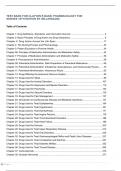Exam (elaborations)
TEST BANK FOR CLAYTON’S BASIC PHARMACOLOGY FOR NURSES 18TH EDITION BY WILLIHNGANZ
- Course
- Institution
TEST BANK FOR CLAYTON’S BASIC PHARMACOLOGY FOR NURSES 18TH EDITION BY WILLIHNGANZ Table of Contents Chapter 1: Drug Definitions, Standards, and Information Sources ..................................................... 2 Chapter 2: Basic Principles of Drug Action and Drug Interactions .............
[Show more]



